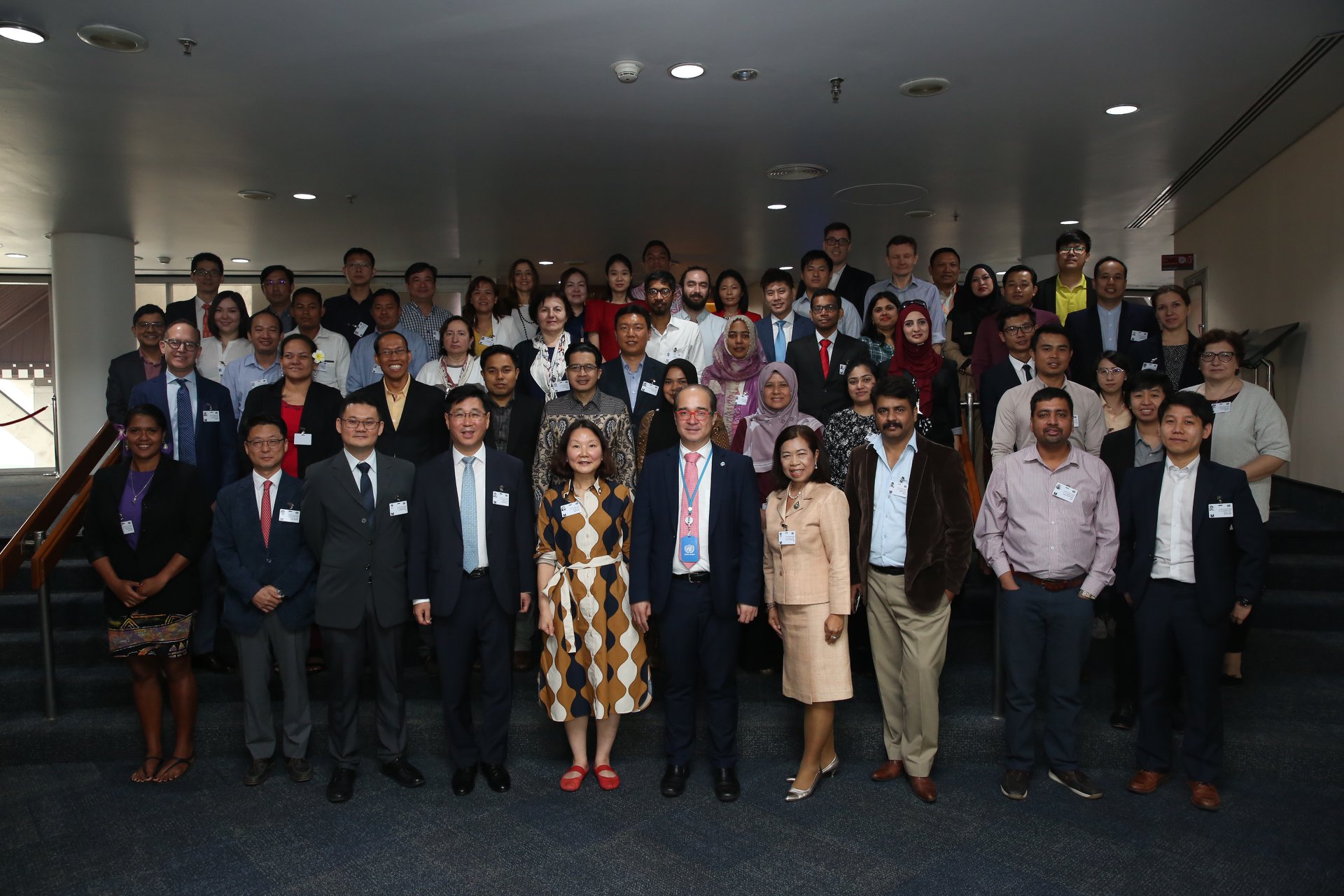[2020] 2nd Greenhouse Gas Inventory System Training Workshop

Description
When the UN Member States adopted the 2030 Agenda for Sustainable Development in September 2015, they accepted the challenge of achieving the 17 Sustainable Development Goals (SDGs) and 169 associated targets. One of these goals, SDG 13 on Climate Action, urges the Member States to take action to mitigate climate change and adapt to its impacts. To address the growing concerns on climate change, 185 Parties of 197 Parties to UNFCCC ratified the Paris Agreement to this date. Under the Agreement, all Member States agreed to work to limit the global temperature rise to well below 2 degrees Celsius above pre-industrial levels, and given the severe risks, to pursue efforts to limit the temperature increase to 1.5 degrees Celsius.
To achieve this goal, there is a need for investments and financial flows in the right direction, technological advancement and capacity building. Member States should encourage this with proactive and ambitious policies. According to the Agreement, each Party has to set their own greenhouse gas (GHG) reduction target, officially communicated through their Nationally Determined Contributions (NDCs). The Agreement also requires monitoring, reporting and verification (MRV) of national level GHG emissions and mitigation efforts. Furthermore, updated NDCs should display increased ambition over the years.
In terms of GHG emissions, 33.4 gigatons of GHG were released into the atmosphere in 2018. The Asia Pacific region accounted for 48.8% of the global total, emitting 16.3 gigatons of greenhouse gases. In the same timeframe, Europe and the US combined were responsible for 6.4 gigatons of GHG emissions, accounting for 19% of global emissions. That is less than half of the Asia Pacific’s GHG emissions. It is therefore obvious that the Asia Pacific region plays a crucial role in achieving GHG reduction goals.
The participation of countries in the Asia Pacific region is critical, even more because they will be disproportionately affected by the consequences of climate change. Six of the ten nations most affected by extreme weather events are in Asia and the Pacific. 410 million Asian urban dwellers will be at risk of coastal flooding by 2050 and in the Pacific, sea levels rise four times faster than the global average. Climate change is expected to hike food prices and push Asians into poverty. The initial step towards GHG emission reduction is the establishment of a transparent and reliable GHG Inventory System. This allows countries to monitor, report and verify the current state of emissions.
Programme
Concept Note and Agenda (Updated as of 15 January 2020)
Opening Remarks
- Ms. Eunhae Jeong (Senior Development Management Expert, UNOSD)
- Ms. Asdaporn Krairapanond (Deputy Permanent Secretary, Ministry of Natural Resources and Environment, Kingdom of Thailand)
- Mr. Stefanos Fotiou (Cheif of Service, Environmental Affairs, UNESCAP of Bangkok, Thailand)
- Ms. Deirdre Boyd (Resident Coordinator, Office of UN Resident Coordinator in Thailand)
Keynote Speech
- "Bangkok Master Plan on Climate Change 2013-2023 for Sustainable Development" - Ms. Termsiri Chongpoonpol (Director of Air Quality and Noise Management Division, Bangkok Metropolitan Administration)
Day 1 (January 13, 2020)
- "Sustainable Development and its Progress in Climate Action" - Ms. Eunhae Jeong (Senior Development Management Expert, UNOSD)
- "Achieving SDGs by 2030: Importance of Climagte Change Regime under the Paris Agreement" - Mr. Suhyong Chung (Professor, Korea University)
- "Climate Change Policy Instruments" - Mr. Okhyun Yang (Associate Research and Policy Expert, UNOSD)
- "Measuring, Reporting, and Verification" - Mr. Yungyul Choi (3rd Party Verifier, Korean Foundation for Quality)
- "Emissions Trading and the Linkage among Countries" - Mr. Quoqiang Qian (Deputy General Manager, SinoCarbon Innvoation & Investment Corporation)
Day 2 (January 14, 2020)
- "Main Contents of 2006 IPCC Guideline Vol.2 (Energy)" - Mr. Engin Mert (Techincal Project Coordinator, PMR Turkey Project)
- "Case Study and GHG Estimation Practice in Energy Sector",(solution) - Mr. Engin Mert (Techincal Project Coordinator, PMR Turkey Project)
- "Main Contents of 2006 IPCC Guildeline Vol.3 (Industrial Processes and Product Use)" - Ms. Heejeong Yim (Director, Erdeliebe Institute)
- "Case Study and GHG Estimation Practice in Industrial Processes and Product Use Sector", (Excel file) - Ms. Heejeong Yim (Director, Erdeliebe Institute)
- "Expereince in Building and Operating Korean National GHG Inventory System" - Mr. Hyung-Wook Choi (Senior Researcher, GHG Inventory and Research Center)
- "Main Contents of 2006 IPCC Guildeline Vol.4 (Agriculture, Forestry and Other Land Use)" - Ms. Mirella Salvatore (Climate Change Officer, Food and Agriculture Organization)
- Group Work of Emissions Trading (Emissions trading scheme simulation game) - Mr.Yungyul Choi (3rd Party Verifier, Korean Foundation for Quality)
Day 3 (January 15, 2020)
- "Main Contents of 2006 IPCC Guideline Vol. 5 (Waste)" - Mr. Christopher Godlove (Principal, THINKcities)
- "Case Study and GHG Estimation Practice in the Waste Sector (SWDS),(Waste water)", (Excel file) - Mr. Okhyun Yang (Associate Research and Policy Expert, UNOSD) and Mr. Christopher Godlove (Principal, THINKcities)
- "Case Study: How to Implement Emissions Trading in Thailand" - Ms. Anothai Sangthong (Director of Carbon Business Office, Thailand Greenhouse Gas Management Organization)
- "Climate Change Technical Training and Training Center" - Thailand Greenhouse GasManagement Organization (TBC)
Day 4 (January 16, 2020)
- "Obtaining Financial Support for GHG Mitigation Projects from the Green Climate Fund" - Mr. Andrei Chicherin (Senior Project Finance Specialist, Green Climate Fund)
- "IPCC 2019 Refinement" - Mr. Kiyoto Tanabe (Co-Chair, IPCC Task Force on National Greenhouse Gas Inventories)
- "Sharing Climate Action Policies from Pariticipating Countries" - Mr. Jong Soo Yoon (Former Head of UNOSD and Former Vice Minister of Environment, Republic of Korea)
Closing Remarks
- Thailand Greenhouse Gas Management Organization (TBD)
Supplementary Documents
Participant List (Updated as of 19 February 2020)
Info Note (Updated as of 31 December 2019)
Speaker Biographies (Updated as of 14 January 2020)
Compiled training Material (Updated as of 19 February 2020)
Outcome Report (Updated as of 19 February 2020)
Photos
Pictures are uploaded here.

